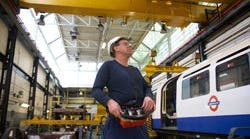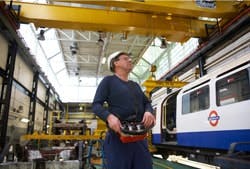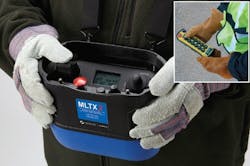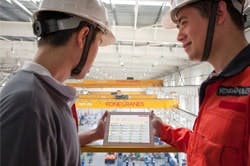Remote control crane operation: Heavy lifting made easy
Cranes are critical in a number of industries, including aircraft/aerospace, auto manufacturing, chemicals and minerals, pulp and paper, steel production, and utilities, as well as the grain industry, logging, rail yards, and ship loading.
Traditionally, industrial cranes have been operated by human operators sitting in cabs in the cranes. In such instances, the operator's actions are guided by the hand signals of a person outside of the crane. "In the past, cranes were operated by the cab operators," says Brad Robinson, president of Robinson Engineering, which has been offering remote control technologies since 1962. "The guy on the ground was hooking the chains, doing the loading, and having to wave his hands to direct the operator where to move the crane."
In other cases, rather than have an operator sitting in a cab, a person outside of the crane would operate the unit, using pendant pushbutton stations suspended from the crane.
In recent decades, technology has advanced to the point where cranes can be operated by remote control. While this technology has been around since the 1960s, it has continued to improve over the years, with newer systems providing more safety, reliability, efficiency, versatility, and cost savings than in the past.
The two standard technologies for remote control crane operation are radio frequency (RF) signals/waves and infrared light. While both continue to be available, the RF technology is the more popular of the two, having about 98 percent of the market, according to Magnetek Material Handling, because of its advantages over infrared technology. For example, infrared units have shorter operating ranges than RF units. In addition, infrared light can be deflected by dust or other airborne particles, and even blocked by larger objects in its path.
"Infrared was a neat idea," says Robinson. "However, in most plants, especially steel mills, there is too much dirt and dust, and all of the reflectors and lenses on the crane get covered in dirt and dust. As a result, you have to constantly clean off sensors and other surfaces."
Technology basics
A remote control system consists of two units. One is a portable transmitter that creates control signals. The other is a receiver that is permanently installed on the crane. The receiver is connected to the crane's control unit. Each switch on the transmitter creates a specified combination of "pulses" that is transmitted to the receiver, which then decodes the "pulses" and transmits them to the crane's motor controllers.
While remote control technology can be purchased already installed in new cranes, the technology can also, in many cases, be retrofitted onto existing cranes. One prerequisite for retrofitting is that the existing crane must be equipped with magnetic motor controllers, rather than drum controllers (the latter are common on many older models of cab-operated cranes). A second prerequisite is that the brakes must be equipped for emergency use and connected with the existing motor controls. For example, hydraulic brakes that are traditionally operated via foot pedal must be converted to allow for electronic actuation.
The technology has been keeping up the with the times. "A lot of smaller and inexpensive remotes are just two-step push-button units that provide direction plus high speed," says Robinson. "As such, they have always worked well for small cranes." However, with the introduction of variable frequency drives (VFDs) a few years ago, most large cranes now have five speeds: slow, slow-medium, medium, medium-high, and high. "This allows you to have more control over the motors and speeds," he says. With advances in technology, remote control units are also able to respond to the need for changes in speed (see Figure 1).
While Robinson Engineering offers a number of different models, its most popular model is the Crane Boss 400, which is custom-made for each crane and, according to Robinson, is primarily used in steel mills. "More than one crane in the same plant can be controlled by the Crane Boss 400," he says. "The system can be installed on existing cranes or can be installed on new cranes at the time of manufacture." The unit can handle as many as seven five-speed or stepless reversing motors with all motions simultaneous and in any combination. It can also control many auxiliary functions, such as magnet lift-drop, lights on-off, interlock latch-unlatch, signal sounding, and brakes.
Another manufacturer, Magnetek, offers a wide range of products, from the most basic to the most complex. "We have cost-effective off-the-shelf systems that would be appropriate for applications such as stick cranes," says Norm Davis, Magnetek radio controls business development manager. At the other end of the spectrum are very complex custom-engineered solutions that require a significant amount of in-house engineering. "A custom-engineered application is appropriate any time there is critical lift that requires a fine level of control or an increased awareness of what is going on with the systems during the lift," says Davis. "Another situation would be when the crane has a lot of different capabilities and requires a higher level of selection for the operator, who may need to control a number of different components of the crane at different times."
Benefits of remote crane controls
One benefit of remote control operation is improved safety. That is, there is no need for an individual to be physically near the crane and its operation and risk being struck either the crane or its load. There is also no need for a human operator inside a crane cab, who could also risk being injured. While injury is less likely to an operator in a cab than to the person outside of the cab, cab operators are still prone to suffer ergonomic injuries (neck, lower back, arm, hand, etc.) as a result of constant bending and control panel manipulation. Fatigue is another problem for cab operators.
Safety is particularly improved when the switch is made from a pendant system to a remote control system. "Smaller cranes tended to have pendants," says Robinson. "Switching to remote control provides more safety, since the person operating the controls can now be further away from the crane and operate it at safer distance, instead of having to operate the pendant right next to the load."
Another benefit of remote control technology is improved efficiency, when the technology is installed on the right cranes. That is, while there are many benefits to remote control crane technology, it is not necessary or appropriate in all situations. This depends largely on how often the crane is being operated. Cranes that operate 90 or 100 percent of the time are best operated by cab-mounted operators. Conversely, cranes that are only operated a couple of times a day are also probably best operated by cab-mounted operators, not because of any human efficiency, but the limited use of the cranes likely does not warrant the costs associated with purchasing and installing remote control technology.
Cranes operating 20 to 80 percent of the time are those that are the most likely candidates for remote control technology, in that these cases are where the greatest efficiencies of the technology will be realized. The reason: One of the individuals who would otherwise be involved in the crane operation – either the cab operator or the outside "spotter" – can be assigned to perform other work (see Figure 2).
According to Robinson, efficiency is particularly improved when the switch is made from a cab operator arrangement to a remote control system. "Radio controlled technology allows you to give complete control to the guy on the ground," he says. "This allows the company to relocate the crane operator to some other useful job." In addition, remote control units allow cranes to operate more quickly, meaning that more work can be done in less time than when units are operated by cab operators.
What do customers want?
What are remote control crane technology customers looking for these days? Demands continue to increase, and manufacturers continue to respond.
According to Magnetek's Davis, one trend is the increasing demand from customers for field serviceability of the units, such as being able to change spare transmitters as needed, or even replace a switch if it is broken. "Being about to do this helps to keep productivity high," he says.
Another trend is the demand from customers for higher reliability, both in terms of rugged design and improved longevity. "More and more customers are demanding higher reliability, especially as it relates to rugged product design," says David Stagg, product manager, industrial portfolio, for Laird Technologies, which has a number of units that offer remote control crane technology: Cattron/Theimeg, Remtron, and Vectran. "Longevity is important, too," he says. "We have some systems that have been operating for 10, 15, and even 20 years."
In addition, there is greater interest from customers in systems that can interface with a hosted programmable logic controller (PLC), instead of having relay outputs. "However, there is still a segment of customers that wants to continue using relay outputs, because it is easier for the maintenance people to diagnose a standard relay system than it is for them to diagnose a system that interfaces with a PLC," says Stagg. "As such, there is a place for both."
"These days, more and more customers are looking for increased diagnostic capabilities," says Magnetek's Davis. One solution the company offers for this is the Radio Drive Serial Interface, or RSDI system, which allows Magnetek radios to converse with Magnetek variable frequency drives (VFDs) through serial communications. The technology that the company uses for serial communication not only provides control of the crane, such as commanding the crane's motions, but also pulls information from the drives and sends it back wirelessly to a display on the transmitter (see Figure 3). "This allows the operator or the maintenance person to gather a lot of information from the crane without having to board the crane to access that information," he says. "One benefit of this is that it allows the maintenance person to determine where he or she will begin troubleshooting activities before having to board the crane. This helps to reduce the amount of downtime."
As noted, while the basic technology of remote control crane systems remains the same, features have continued to be added over the years. One company focused on this is Konecranes, which offers TRUCONNECT, a suite of remote service products that connect data, equipment and people. Besides offering traditional features, Konecranes has developed a series of "smart" features, each of which can be applied to old and new cranes. Features include sway control, inching, microspeed, shock load prevention, slack rope prevention, hoisting synchronization, extended speed range, target positioning, end positioning, working limits, and protected areas (see Figure 4).
"Additional smart features, such as side pull prevention, are being readied for market launch in 2015," says Scott Gilbey, director of services and industry marketing for Konecranes. "TRUCONNECT Remote Services will also expand to include more sensors, data points, and analytics, with a goal of putting real-time information into the hands of customers."
More and more, according to Gilbey, industrial customers want the benefits of easy access to data that connects their machines with the people who need to make decisions about those machines. "Knowing what happened yesterday is interesting, but knowing what is happening now, in real time, is much more useful when monitoring production and planning maintenance," he says. "The next frontier is being able to analyze trends and apply predictive maintenance." Yet, he believes, technology alone will not be sufficient. "Human experience and expertise will be needed to turn data into useful and actionable information," he says.
When it comes to radio control technology for cranes, there are not only benefits to introducing the technology in the first place to replace manually-operated cranes, but there are also benefits to continuing to update the technology in order to continue to maximize productivity and safety benefits.
The Rock Island Dam in central Washington State, owned by the Chelan County Public Utility District (PUD) was the first dam to span the Columbia River. The dam, which has been in operation since the 1930s, has received a number of expansions and upgrades over the decades. Cranes, of course, were and continue to be an important part of these upgrades and improvements, as well as the operation of the dam. For example, a rehab project that began in 2006 on one of the turbines that had been originally installed in the 1950s began with the replacement of four cranes: a new 80-ton transfer crane, a 20-ton draft tube gantry crane, and two 80-ton powerhouse bridge cranes.
"All of the major cranes at Rock Island, a total of eight, have radio controls," says Carey Schenck, P.E., a project engineer with the PUD.
Recently, the PUD elected to upgrade the technology. "We wanted to replace aging radio controls that were unreliable and becoming difficult to service and repair," he says. The PUD selected a Magnetek (www.magnetek.com) 18K receiver, which was meant to be a direct replacement for an older radio control. "Our supplier found and recommended the replacement based on the old part numbers," said Schenck. "The new radio controls have been working well. We have realized better reliability."
In addition, realizing the importance of having the most up-to-date technology, Schenck noted that the PUD would consider additional upgrades in the future if necessary in order to make sure that its cranes can continue to operate at maximum safety and performance levels.
Another company committed to maintaining the latest remote control crane technology is NLMK Pennsylvania (www.us.nlmk.com/nlmk-pa), a member of NLMK Group, which produces a range of steel products. Following a rebuild in 2004 of its 1955 Pawling & Harnischfeger (P&H) overhead shipping crane, NLMK Pennsylvania equipped the crane with a radio control. Then, in late 2012, the company elected to update the radio remote control system, installing a Laird LRC-M1/CT radio remote control, part of Laird's new CattronControl product series. The unit allows control of up to four motions with two multi-axis joystick controllers.
"The crane is used anywhere between 40 and 60 hours a week, primarily for shipping outbound products," says Al Stull, electrical maintenance area supervisor for the plant. "It was important that we had a reliable and easy to use remote control system." The crane has a 35-ton main hoist and a 15-ton auxiliary hoist, with a control voltage of 250VDC. Because of its heavy use, it required a rugged but also user-friendly remote control. "Our operators really prefer the weight of the Laird control over our older model," he says. "It is much easier to use. It was also very easy to install, since the drawing package was 100 percent accurate."




